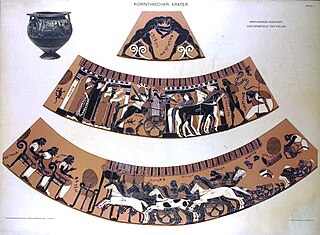 W
WThe Amphiaraos krater is a Late Corinthian red-ground column krater. It is considered the masterpiece of the Amphiaraos Painter and one of the major specimens of the red-ground vase painting of Corinth.
 W
WThe Arkesilas Cup is a kylix by the Laconian vase painter known as the Arkesilas Painter, whose name vase it is. It depicts, and is thus named after, Arkesilaos II, king of Kyrene and is dated to about 565–560 BC.
 W
WThe Berlin Foundry Cup is a red-figure kylix from the early 5th century BC. It is the name vase of the Attic vase painter known conventionally as the Foundry Painter. Its most striking feature is the exterior depiction of activities in an Athenian bronze workshop or foundry. It is an important source on ancient Greek metal-working technology.
 W
WThe bilingual eye-cup by the Andokides painter in the Museo Archeologico Regionale, Palermo, is a prime example of the transition from black-figure vase painting to the red-figure style in the late 6th century to early 5th century that commonly resulted in "bilingual" vases, using both styles. The Andokides painter created the red-figure style of pottery as we know it today during his working years from 530–515 BC. Starting around 530 BC the Andokides painter produced red-figure amphorae and a bilingual kylix. Fewer than 20 vases survive by the Andokides painter but they span 30-40 years of his career, allowing historians to trace the development of his painting styles. One of the earliest mentions of the Andokides painter was on a black-figure hydria by Timagoras around 550 BC, when the Andokides painter must have been an apprentice.
 W
WThe Brygos Cup of Würzburg is an Attic red-figure kylix from about 480 BC. It was made by the Brygos potter and painted by the man known as the Brygos Painter. It depicts some of the best-known images of ancient Greek pottery.
 W
WThe calyx-krater by the artist called the "Painter of the Berlin Hydria" depicting an Amazonomachy is an ancient Greek painted vase in the red figure style, now in the Metropolitan Museum of Art, New York. It is a krater, a bowl made for mixing wine and water, and specifically a calyx-krater, where the bowl resembles the calyx of a flower. Vessels such as these were often used at a symposion, which was an elite party for drinking.
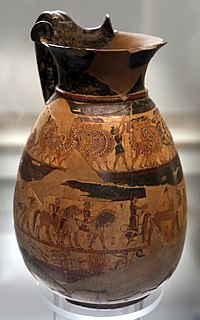 W
WThe Chigi vase is a Proto-Corinthian olpe, or pitcher, that is the name vase of the Chigi Painter. It was found in an Etruscan tomb at Monte Aguzzo, near Veio, on Prince Mario Chigi’s estate in 1881. The vase has been variously assigned to the middle and late Proto-Corinthian periods and given a date of ca. 650–640 BC; it is now in the National Etruscan Museum, Villa Giulia, Rome. The vase stands 26 cm tall, which is modest compared to other Greek vases. Some three-quarters of the vase is preserved. It was found amidst a large number of potsherds of mixed provenance, including one bucchero vessel inscribed with five lines in two early Etruscan alphabets announcing the ownership of Atianai, perhaps also the original owner of the Chigi vase.
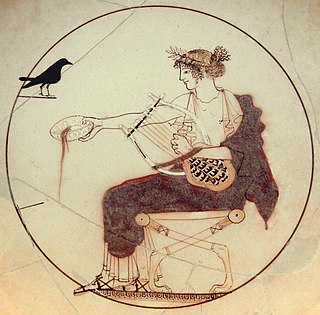 W
WThe few pottery exhibits of the Delphi Archaeological Museum include a famous shallow bowl (kylix) with an unusual depiction of the god Apollo. In the white-ground red-figure technique, it was found in a grave underneath the museum.
 W
WThe Darius Vase is a famous vase painted by an anonymous Magna Graecia Apulian vase painter, commonly called the Darius Painter, the most eminent representative at the end of the "Ornate Style" in South Italian red-figure vase painting. The vase was produced between 340 and 320 BCE, probably in a large factory-like workshop in the Greek city of Taranto, Magna Graecia, well before the fall of Taranto to the Romans in 272 BCE. It is an important part of Apulian vase painting.
 W
WThe Dinos of the Gorgon Painter is an important example of ancient Greek pottery, produced at Athens around 580 BC. It entered the Louvre's collection in 1861, with the purchase of Giampietro Campana's collection.
 W
WThe Dionysus Cup is the modern name for one of the best known works of ancient Greek vase painting, a kylix dating to 540–530 BC. It is one of the masterpieces of the Attic black-figure potter Exekias and one of the most significant works in the Staatliche Antikensammlungen in Munich.
 W
WDipylon kraters are Geometric Period Greek terracotta funerary vases found at the Dipylon cemetery, near the Dipylon Gate, in Kerameikos, the ancient potters quarter on the northwest side of the ancient city of Athens. A krater is a large Ancient Greek painted vase used to mix wine and water, but the large kraters at the Dipylon cemetery served as grave markers.
 W
WThe Eleusinian Mysteries Hydria is a 4th-century BC ancient Greek red-figure hydria, showing the reunion of Demeter and Persephone at the start of each spring. It was used for the celebration of the Eleusinian Mysteries, a secret cult of the two goddesses and of the rebirth of nature. It is painted in the Kertch style. It is now in the Museum of Fine Arts of Lyon.
 W
WThe Euphorbos plate is the name of an East Greek plate with mythological painting in the Orientalising style.
 W
WThe Euphronios Krater is an ancient Greek terra cotta calyx-krater, a bowl used for mixing wine with water. Created around the year 515 BC, it is the only complete example of the surviving 27 vases painted by the renowned Euphronios and is considered one of the finest Greek vase artifacts in existence. Part of the collection of the Metropolitan Museum of Art from 1972 to 2008, the vase was repatriated to Italy under an agreement negotiated in February 2006, and it is now in the collection of the Archaeological Museum of Cerveteri as part of a strategy of returning stolen works of art to their place of origin.
 W
WThe Eurymedon vase is an Attic red-figure oinochoe, a wine jug attributed to the circle of the Triptolemos Painter made ca. 460 BC, which is now in the Museum für Kunst und Gewerbe Hamburg (1981.173) in Hamburg, Germany. It depicts two figures; a bearded man, naked except for a mantle, advances holding his erection in his right hand and reaching forward with his left, while the second figure in the traditional dress of an Oriental archer bends forward at the hips and twists his upper body to face the viewer while holding his hands open-palmed up before him, level with his head. Between these figures is an inscription that reads εύρυμέδον ειμ[í] κυβα[---] έστεκα, restored by Schauenburg as "I am Eurymedon, I stand bent forward". This vase is a frequently-cited source suggestive of popular Greek attitudes during the Classical period to same-sex relations, gender roles and Greco-Persian relations.
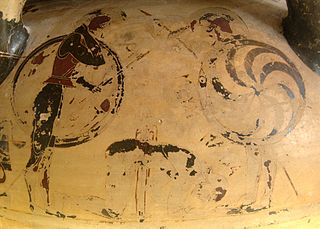 W
WEurytios Krater is the name given to a famous Early Corinthian column krater. The Eurytios krater is dated to about 600 BC. The vase combined the possibilities of the recently invented or introduced styles of black-figure vase painting and polychrome painting in terms of shape and decoration of the vase with a particularly high quality of artisanship.
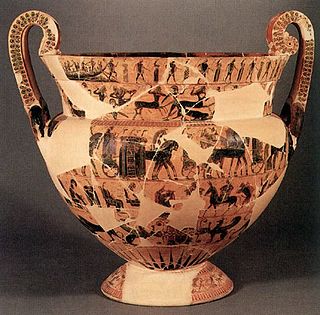 W
WThe François Vase is a large Attic volute krater decorated in the black-figure style. It stands at 66 cm in height and was inspired by earlier bronze vases. It was used for wine. A milestone in the development of ancient Greek pottery due to the drawing style used as well as the combination of related stories depicted in the numerous friezes, it is dated to circa 570/560 BCE. The Francois Vase was discovered in 1844 in Chiusi where an Etruscan tomb in the necropolis of Fonte Rotella was found located in central Italy. It was named after its discoverer Alessandro François, it is now in the Museo Archeologico at Florence. It remains uncertain whether the krater was used in Greece or in Etruria, and whether the handles were broken and repaired in Greece or in Etruria. Perhaps the François Vase was made for a symposium given by a member of an aristocratic family in Solonian Athens, then broken and, after being carefully repaired, was sent to Etruria, perhaps as an instance of elite-gift exchange. It bears the inscriptions Ergotimos mepoiesen and Kleitias megraphsen, meaning 'Ergotimos made me' and 'Kleitias painted me'. It depicts 270 figures, 121 of which have accompanying inscriptions which is highly unusual for so many to be identified; the scenes depicted represent a number of mythological themes. In 1900 the vase was smashed into 638 pieces by a museum guard by hurling a wooden stool against the protective glass. It was later restored by Pietro Zei in 1902, followed by a second reconstruction in 1973 incorporating previously missing pieces.
 W
WHeracles and the Lion of Nemea is a lekythos which is held at the Louvre Museum, with the representation of the first of the labours of Hercules, the slaying of the Nemean lion. It is coming from Athens, dated around 500 – 450 BCE and it was bought for Louvre Museum at 1870. It was probably created from the shop of a Tanagran artist. According to Beazley and Haspels it is attributed to the Diosphos Painter.
 W
WThe Horse Amphora is the name given to a Melian pithamphora in the National Archaeological Museum, Athens with the inventory number 913. It is dated to around 660 BC.
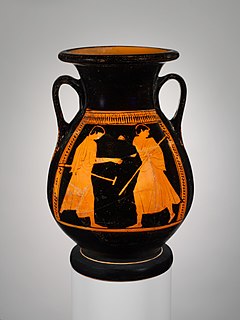 W
WA pelike was a ceramic container that the Greeks used as storage/transportation for wine and olive oil. As seen in the picture on the right, it had a large belly with thin, open handles. Unlike other transportation jars, a pelike would have a flattened bottom so that it could stand on its own. Pelikes often had one large scene across the belly of the jar with minimal distractions around. This would focus the viewers eyes to the center of the pelike which was often a mythological scene of sorts.
 W
WThe Macmillan aryballos is a Protocorinthian pottery aryballos in the collection of the British Museum. Dating to about 640 BC, it is 6.9 cm high and 3.9 cm in diameter, and weighs 65 grams.
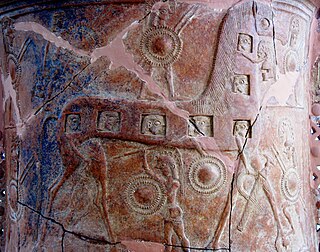 W
WThe Mykonos vase, a pithos, is one of the earliest dated objects to depict the Trojan Horse from Homer's telling of the Trojan war in the Iliad. It was found in 1961 on Mykonos, the Greek island for which it is named, by a local inhabitant.
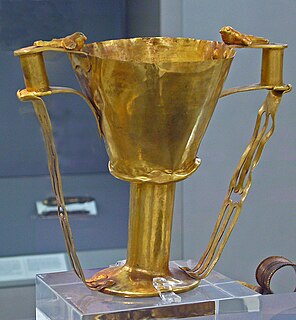 W
WThe Cup of Nestor or dove cup is a gold goblet discovered in 1876 by Heinrich Schliemann in Shaft IV of Grave Circle A, Mycenae. The cup has two handles, each decorated with a golden bird, which Schliemann observed was reminiscent of the cup of Nestor described in the Iliad. The birds have since been identified by Spiros Marinatos as falcons, rather than the doves which are on the Iliadic cup. J.T. Hooker suggests that the cup is an adaptation of a Cretan design made by a craftsman on the Greek mainland.
 W
WNestor's cup is an eighth century BC wine cup discovered in 1954 in Lacco Ameno on Ischia, the ancient Pithekoussai, an island in the Gulf of Naples (Italy). The cup has a three-line inscription, one of the earliest surviving examples of writing in the Greek alphabet.
 W
WThe Oinochoe by the Shuvalov Painter in the Antikensammlung at Berlin is an erotic depiction from ancient Greek vase painting.
 W
WPelike with actors preparing is a two-handled jar (pelike) depicting actors preparing for a performance. It is a piece of red-figure pottery measuring 24.1 centimetres (9.5 in) in height and 18 centimetres (7.1 in) in diameter. It was manufactured in Athens between 440–430 BC by the Phiale Painter and is held in the Greek Classical Gallery at the Museum of Fine Arts (MFA) in Boston. It is thought to have been used for storage.
 W
WThe Regina Vasorum or Queen of Vases is a 4th-century BC hydria from Cumae depicting Eleusinian divinities with gilded flesh in polychrome relief. It is held in the collections of the Hermitage Museum, St. Petersburg. In addition to its aesthetic qualities, it is valued as an iconographical source for ancient Greek religion.
 W
WThe Three Revelers Vase, also known as simply the Revelers Vase, is a Greek vase originating from the Archaic Period. Painted around 510 BCE in the red figure pottery style, the Revelers vase was found in an Etruscan tomb in Vulci, Italy. The painting is attributed to Euthymides. Although the vase is in the amphora shape, its purpose is more decorative than functional. The painting itself shows three nude partygoers and Hector arming on the reverse. The work is remarkable because of the early use of foreshortening as opposed to conventional profile and frontal views. The Revelers Vase currently resides in the Staatliche Antikensammlungen in Münich, Germany.
 W
WThe Mycenaean Warrior Vase, found by Heinrich Schliemann on the acropolis of Mycenae, is one of the prominent treasures of the National Archaeological Museum, Athens. The Warrior Vase, dated to the 12th century BCE, is probably the best-known piece of Late Helladic pottery. It is a krater, a mixing bowl used for the dilution of wine with water, a custom which the ancient Greeks believed to be a sign of civilized behavior.